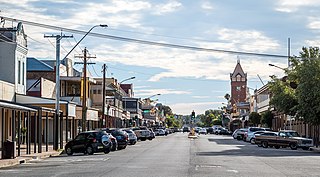
Broken Hill is an inland mining city in the far west of outback New South Wales, Australia. It is near the border with South Australia on the crossing of the Barrier Highway (A32) and the Silver City Highway (B79), in the Barrier Range. It is 315 m (1,033 ft) above sea level, with a hot desert climate, and an average rainfall of 235 mm (9 in). The closest major city is Adelaide, the capital of South Australia, which is more than 500 km (311 mi) to the southwest and linked via route A32.

BHP, formerly known as BHP Billiton, is the trading entity of BHP Group Limited and BHP Group plc, an Anglo-Australian multinational mining, metals and petroleum dual-listed public company headquartered in Melbourne, Victoria, Australia.
BHP, bhp or similar may refer to:

Cobar is a town in central western New South Wales, Australia whose economy is based mainly upon base metals and gold mining. The town is 712 km (442 mi) by road northwest of the state capital, Sydney. It is at the crossroads of the Kidman Way and Barrier Highway. The town and the local government area, the Cobar Shire, are on the eastern edge of the outback. At the 2016 census, the town of Cobar had a population of 3,990. The Shire has a population of approximately 4,700 and an area of 44,065 square kilometres (17,014 sq mi).
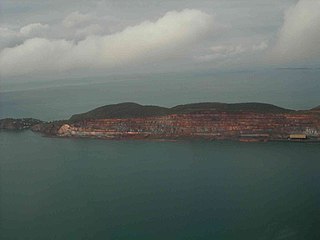
Cockatoo Island is an island in the Buccaneer Archipelago off the coast of Western Australia near the town of Derby. It was mined for iron ore by the Broken Hill Proprietary Company from 1951 until 1984. Koolan Island is a neighbouring island that was also mined by BHP for high grade iron ore. It is now owned by Perth-based mining company, Pluton Resources.
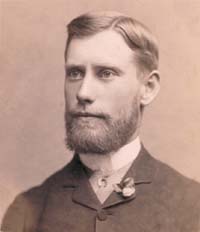
The Syndicate of Seven is the name given to the original members of the Broken Hill Mining Company formed in 1883, who lodged applications for mining leases along the Line of Lode at Broken Hill in New South Wales, Australia.

Charles Rasp, born Hieronymous Salvator Lopez von Pereira, is known as the first person to identify the economic potential of the ore deposits at Broken Hill, New South Wales, Australia.

Adelong is a small town in the Riverina region of New South Wales, Australia, situated on the banks of the Adelong Creek. Adelong sits on the Snowy Mountains Highway and is a part of the Snowy Valleys Council. At the 2016 census, Adelong had an urban population of 943.

The ruined remains of Llys Euryn sit upon a wooded shoulder of Bryn Euryn — a limestone hill on the outskirts of Rhos-on-Sea in the county of Conwy, north Wales. Three sides of the building remain, with the remains of interior walls, a complete fireplace and chimney stack rising to around 50 feet, two other fireplaces and windows. More than anything else, its history makes this one of the more intriguing and important historical buildings in north Wales.

Joadja is a historic town, now in ruins, in the Southern Highlands of New South Wales, Australia, in Wingecarribee Shire. The remnants of the town were added to the New South Wales State Heritage Register on 5 November 1999.

The Broken Hill Ore Deposit is located underneath Broken Hill in western New South Wales, Australia, and is the namesake for the town. It is arguably the world's richest and largest zinc-lead ore deposit.

The Barrier Miner was a daily English language broadsheet newspaper published in Broken Hill in far western New South Wales from 1888 to 1974.

Broken Hill Post Office is a heritage-listed post office at 258-260 Argent Street, Broken Hill, City of Broken Hill, New South Wales, Australia. The original building was designed by James Barnet, and was built from 1890 to 1892 by John Dobbie. Walter Liberty Vernon designed a telegraph office addition in 1900. The property is owned by Australia Post. It was added to the New South Wales State Heritage Register on 22 December 2000. It was added to the Australian Commonwealth Heritage List on 08 November 2011.

Day Dream Smelter is a heritage-listed former smelter and now archaeological site located on an unnamed road at Broken Hill, New South Wales, Australia, approximately 20 km north-west of Broken Hill town. The property is owned by the Broken Hill City Council. It was added to the New South Wales State Heritage Register on 2 April 1999.
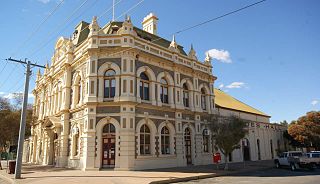
The Broken Hill Trades Hall is a heritage-listed trades hall at 34 Sulphide Street, Broken Hill, City of Broken Hill, New South Wales, Australia. It was designed by Tom Jackson and built from 1898 to 1905. The property is owned by the Trades Hall Trust. It was added to the New South Wales State Heritage Register on 2 April 1999.
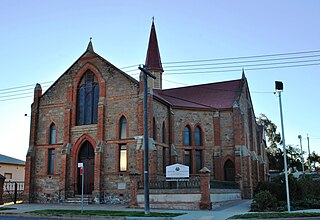
Wesley Uniting Church is a heritage-listed Uniting church at Cobalt Street, Broken Hill, City of Broken Hill, New South Wales, Australia. It was designed by Frederick William Dancker and built from 1885 to 1888 by Messrs. Walter and Morris. It is also known as Wesley Uniting Church and Hall Group, Wesleyan Uniting Church Group, Wesley Church and Wesley Hall. The property is owned by the Uniting Church in Australia. It was added to the New South Wales State Heritage Register on 23 April 2010 and on the Australian Register of the National Estate.
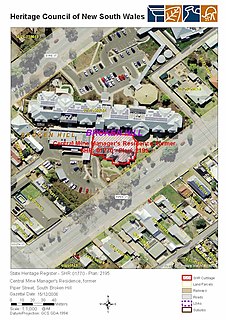
Central Mine Manager's Residence is a heritage-listed former residence, orphanage for Aboriginal girls and now nursing home administration building at Piper Street, South Broken Hill, City of Broken Hill, New South Wales, Australia. It was built in 1903. It is also known as St Anne's Home of Compassion. The property is owned by Southern Cross Care Broken Hill Incorporated. It was added to the New South Wales State Heritage Register on 15 December 2006.
James Hebbard was a miner who became manager of the Great Central Mine, Broken Hill.
William Jamieson was an Australian surveyor, and a member of the syndicate that founded the Broken Hill Proprietary mine at Broken Hill. He was, in 1884, the company's first mine manager and, in 1885, its first general manager.
MathewBuchan Jamieson, was a Scottish-born engineer in Australia, closely identified with the young town of Broken Hill, New South Wales.



















